
Aaron Foyer
Vice President, Research and Analytics
The two realities are clearly in tension

Aaron Foyer
Vice President, Research and Analytics
As news outlets across the world tracked a group of American B-2 Spirit bombers making their way west across the Pacific Ocean last month, presumed to be a threat to coerce Iran into striking a deal on its uranium enrichment program, a second group of bombers moved east, in secret, across the Atlantic.
Leaving from an airbase in Missouri and helped along the way by several refueling aircraft to keep the bombers airborne for the 18-hour flight, the pilots of the seven stealth bombers dropped a total of 14 colossal bombs on two Iranian nuclear sites, Fordow and Natanz. The GBU-57 MOP bombs are so large, B-2 bombers are the only planes in the world capable of carrying them. The 30,000-lb ordinances were designed specifically to hit targets deep underground and had never been used in combat prior to hitting Iran last month.
Moments after the bunker-busters hit their targets, a US submarine hidden off the coast in the Arabian Sea fired two dozen Tomahawk cruise missiles at a nuclear technology center in Isfahan.
The goal: Operation Midnight Hammer was designed as a swift move to kneecap the uranium enrichment efforts of the Iranian government. Both Fordow and Natanz are — or at least were, prior to the bombings — thought to be core to Iran’s nuclear fuel cycle infrastructure. Each was believed to house thousands of centrifuges working to produce ever-increasing volumes of enriched uranium.
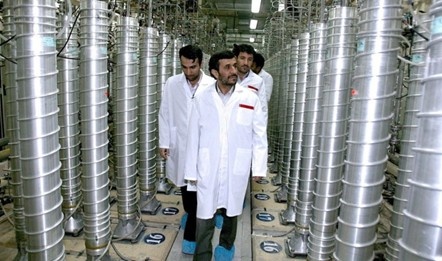
Former Iranian president Mahmoud Ahmadinejad touring the Natanz centrifuges // Nuclear Threat Initiative
The tensions: Iran is not alone challenging international nuclear authorities. Brazil has active centrifuges, but is yet to sign the International Atomic Energy Agency’s Additional Protocol that helps verify a state’s nuclear program is used for peaceful purposes only. Neither has Saudi Arabia, which will likely start its own domestic uranium enrichment in the near future. And despite having already tested nuclear weapons, it’s about as easy to get North Korea to sign a non-proliferation agreement as it is to get Taylor Swift to sign an autograph these days. Depending on where you sit in our multi-polar world, some of those countries with the ability to enrich uranium seem more menacing and concerning than others.
At the same time, nuclear power is one of the most interesting technologies in the energy space, one with rare bipartisan support. On a recent COB Tuesday podcast, Maynard Holt, CEO of the energy research and investment firm Veriten, described nuclear as “the hot flavor.” And many of the most advanced new nuclear reactors require fuels with higher enrichment levels than conventional ones.
These two realities are clearly in tension.
So, can advanced nuclear reactors, with their need for more highly enriched uranium, find success in an increasingly polarized and fractured geopolitical world hostile to upgrading uranium? Let’s find out and get enriched.
It’s worth taking a quick second to understand uranium, the main fuel used for both nuclear power plants and atomic weapons.
Chemistry 101: Uranium atoms are big, with 92 protons at their core. Add 143 neutrons and you get U-235. Add 146 and you get U-238, a slightly heavier version. Both are uranium, just with different weights.
While U-238 is the heavier, chiller uranium cousin, U-235 is the active one needed to sustain a chain reaction. To do so requires a higher concentration of the active uranium atom than is found in nature. Enrichment is simply the process to boost the concentration of U-235 to useful levels.
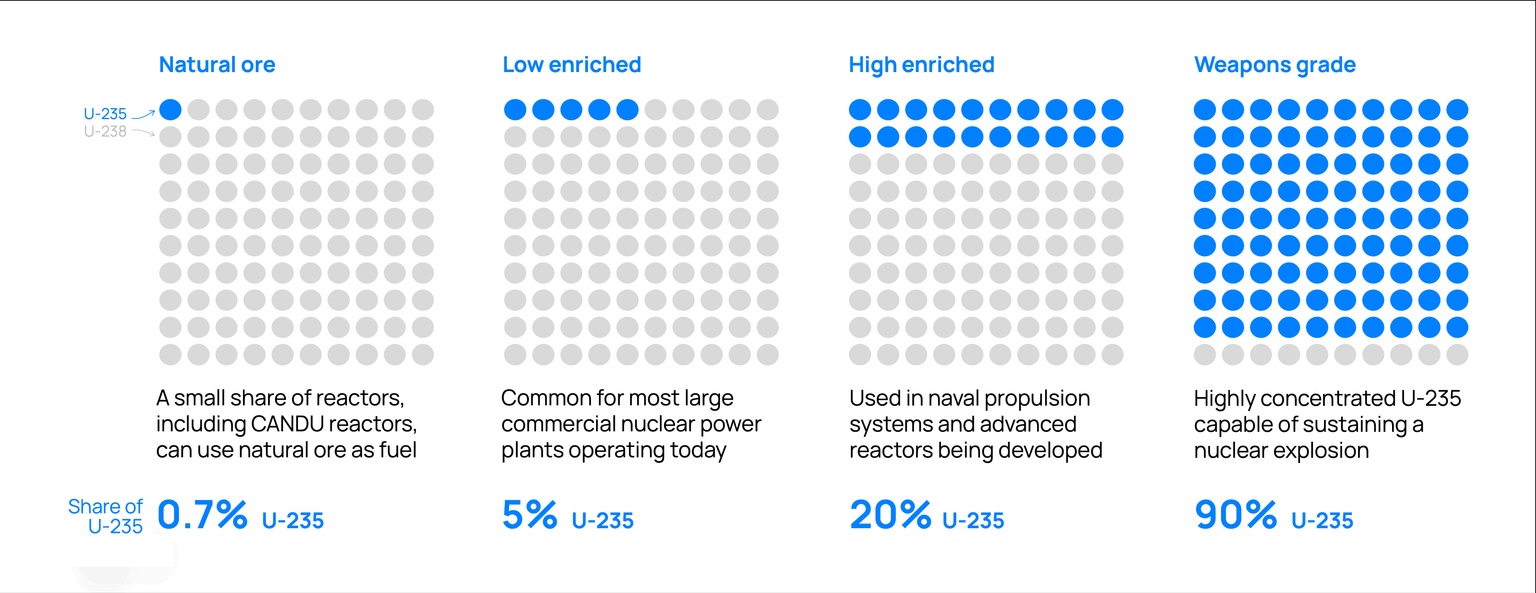
Source: World Nuclear Association
The main enrichment process today uses gas centrifuges and exploits the fact that U-238 is just slightly heavier than U-235.
The key to making uranium useful first involves turning it into a gas, with much of the fuel supply chain focused on this task. Once the desired uranium hexafluoride gas is produced, it’s put into centrifuges, essentially tall metal salad spinners that whirl the gas around. And just like water flung off arugula in the salad spinner, the heavier U-238 is driven outwards in the centrifuge, concentrating the lighter U-235 in the center where it can be collected.
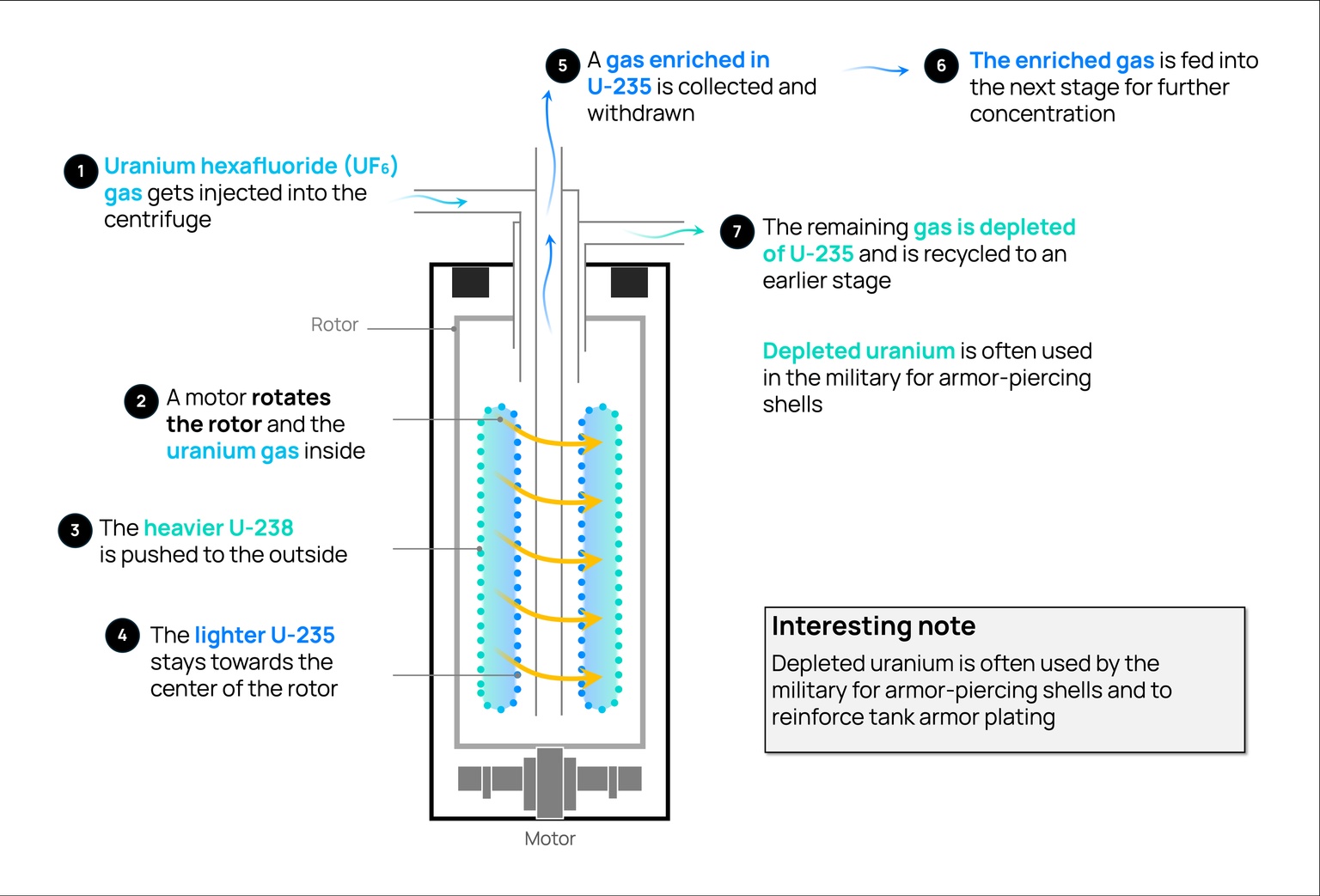
Source: Adapted from the World Nuclear Association
The process is then repeated, each time increasing the share of the active U-235 in the gas until it reaches the desired concentration to match the use.
But enrichment is a slippery slope: The duality of uranium is that the same atom with great potential for abundant clean energy carries with it the potential to cause great harm. And the enrichment process is non-linear, meaning it happens much quicker at the end. It can take months to increase the concentration of uranium from natural levels (0.7%) up to 60%, yet just days to go from there to weapons-grade material (90%).
In quarterly reports published by the IAEA about Iran’s own enrichment program, the country had been actively producing uranium enriched up to 60%. Many believed the country would need only two weeks to take its existing stockpile and upgrade enough of it to produce five to eight bombs worth of weapons-grade uranium. This pace of enrichment at the very end keeps authorities focused on non-proliferation awake at night and why the US administration felt compelled to act so quickly and dramatically.

Source: Data: International Atomic Energy Agency (IAEA)
Nonetheless, despite the clear and present risks with upgrading uranium too far, there are also some clear advantages in exploring new fuels.
A new generation of entrepreneur and reactor designer is thinking about nuclear plants differently, including their fuel. Unlike today’s large conventional reactors, which typically use low enriched uranium (LEU) fuel with a U-235 content of 3% to 5% by weight, many of the advanced and micronuclear designs being put forward would run on a fuel enriched to between 5% and 20%.
Known as high-assay low-enriched or “HALEU,” these fuels are ideal for the compact, high-performance cores needed for the small, yet powerful reactors.
The advantages: By turning to fuels with a higher concentration of the active U-235 atom, reactors can extract more energy from a given volume of fuel. This has the dual benefit of reducing the overall size needs of the reactor and producing less nuclear waste, because more of the radioactive fuel is being used in the process to generate power.
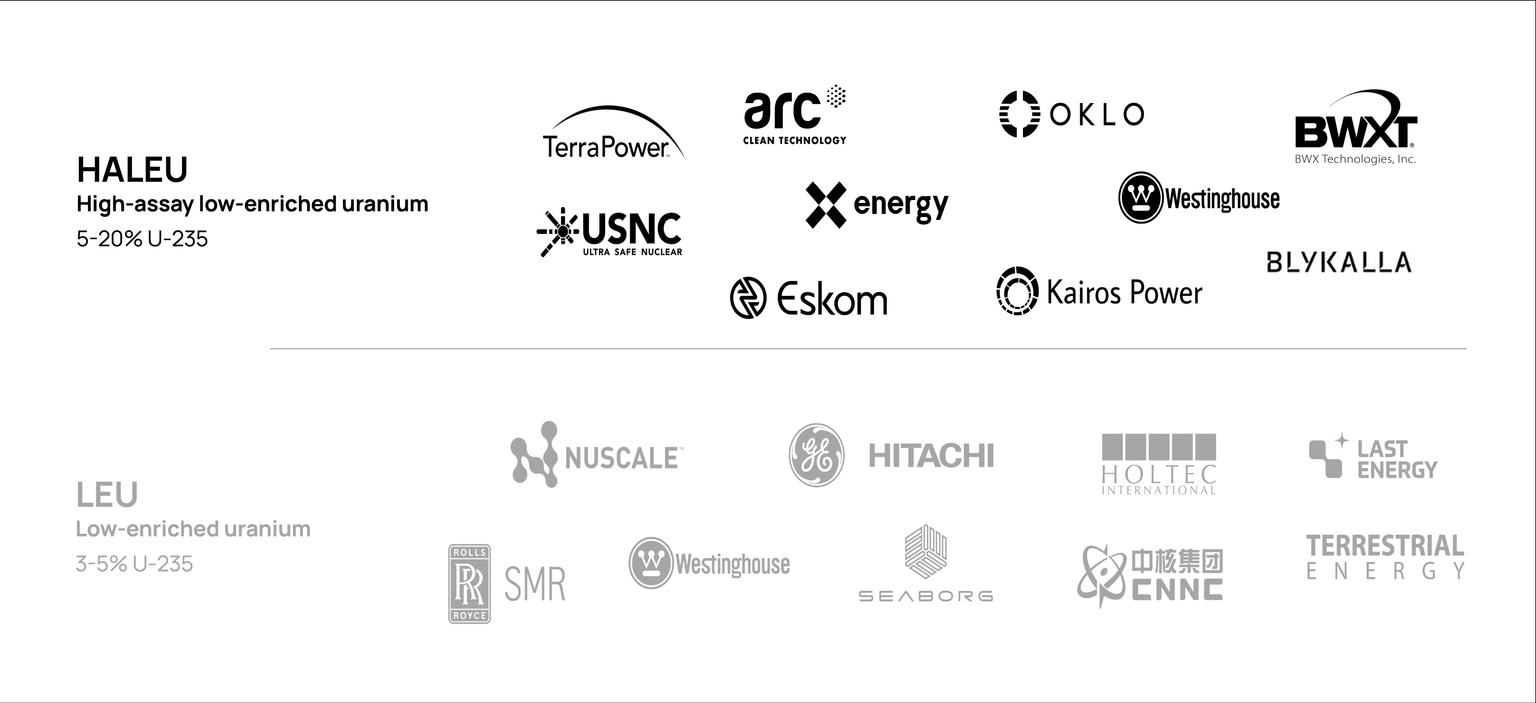
Source: Data: Nuclear Energy Agency
On top of that, the enriched fuel allows plants to go much longer before needing to be refueled. Large nuclear plants operating today will shut down every 18 to 36 months to refuel, but many advanced SMRs and microreactors are looking to have fuel lifespans on the order of 10 years.
And the greater U-235 concentration has the added perk of generating higher temperatures. Your conventional light-water reactor runs at around 300 to 350°C (572 to 662°F) whereas an advanced reactor that uses HALEU fuel can run closer to 700 to 800°C.
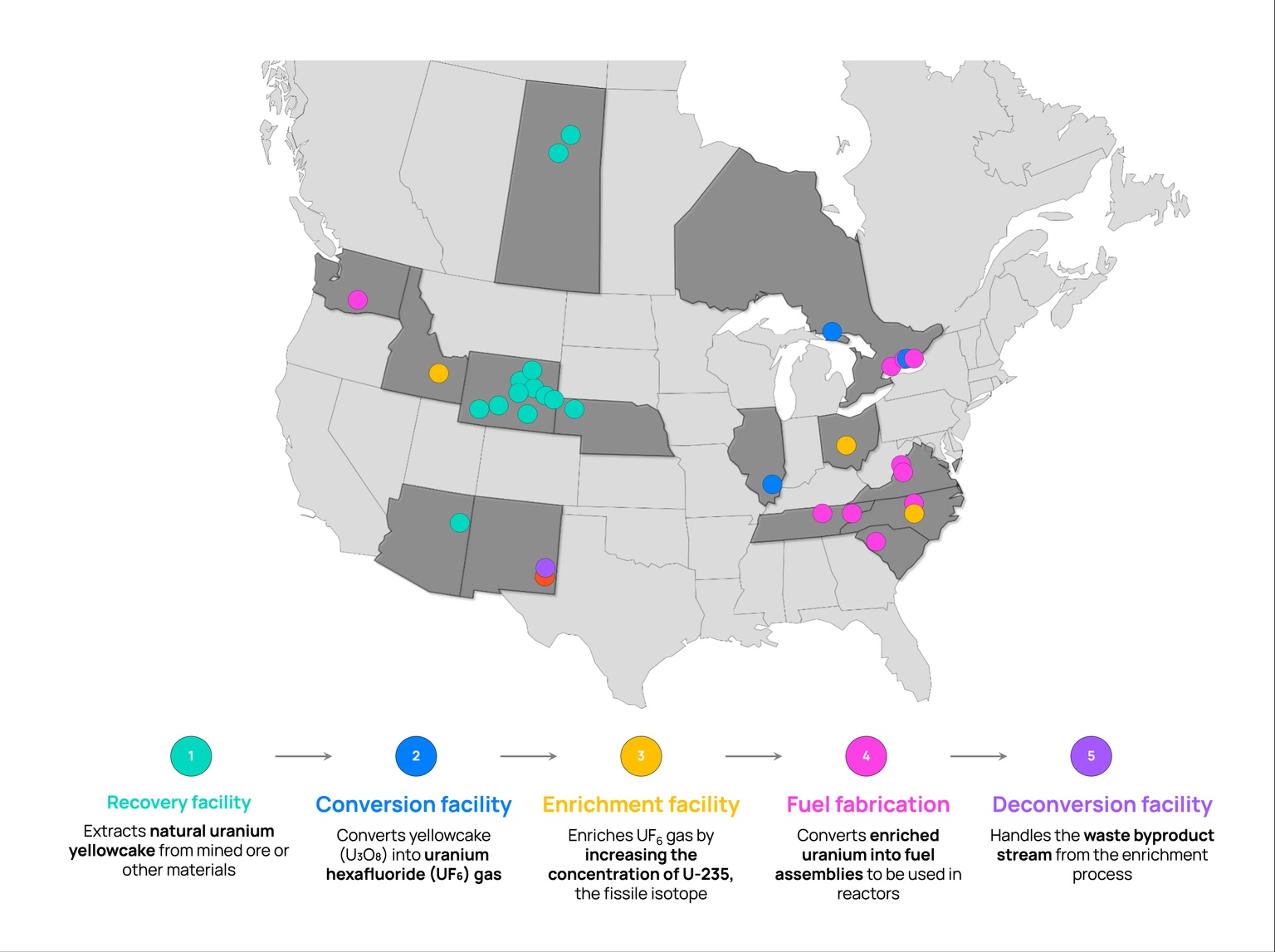
Source: US Nuclear Regulator Commission, Canadian Nuclear Safety Commission
The additional heat both improves the efficiency of the plant and can be used to make industrial heat for hard-to-abate industries like aluminum and ammonia production.
There is little discussion about the implications of the uranium enrichment needs of the future nuclear industry in our new geopolitical age, but there should be.
Eroded trust: Operation Midnight Hammer did more than (purportedly) cripple Iran’s nuclear capabilities: it fundamentally weakened global non-proliferation. With few exceptions, the non-proliferation treaty (NPT) has successfully limited atomic weapons-making across the world for nearly 60 years. Far more countries have started and voluntarily stopped their own atomic weapon programs because of the NPT than have successfully developed them. But the Pentagon’s move risks diminishing the treaty’s perceived strength.
According to Eurasia Group, the operation “disregarded the [non-proliferation treaty] mechanisms entirely, something that could raise doubts about the value of the treaty among other countries that are party to it.”
And, as Matthew Bunn, professor of energy, national security and foreign policy at the Harvard Kennedy School put it, “Countries that fear they may be on the pointy end of an American stick will be more motivated than before to seek nuclear weapons.”
At the same time, if advanced nuclear power emerges as a desirable source of clean power, a strict adherence to the UN’s NPT may be viewed by emerging countries as a means to maintain global spheres of control than peacekeeping.
Bottom line: As a new and exciting age of nuclear power emerges, one with reactors that often require fuels enriched by an order of magnitude higher than some of today’s fuels, non-proliferation is more important than ever.
The global checks on nuclear programs need to be ever more vigilant, not subject to the whims of whoever happens to control a fleet of B-2 bombers.
Data-driven insights delivered to your inbox.